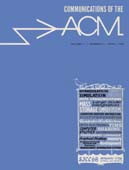April 1968 - Vol. 11 No. 4

Features
The expanding world of computers
The onward sweep of automatic processing of information is impeded by nine principal barriers: geography, cost, problem complexity, man-machine communication, inadequate sensors, lack of understanding, distance, time, and size. The main incentive for breaching these barriers is the universal need for processing information, ever more urgent as the greater part of human work activity changes from production to service.
Computer developments in hardware, programming, time-sharing, education, data communication, and displays are judged by how effectively they remove these barriers, and their barrier-smashing potentialities indicate continued rapid expansion. Problem-oriented languages are particularly effective over the entire front. Online computers and time-sharing also rate high by this measure. Education and increased understanding are basic to all progress with the computer.
This complex but powerful tool is the most important one available to governments and scientists to use in studying the problems being created by the population explosion, and in analyzing possible solutions.
A global parser for context-free phrase structure grammars
An algorithm for analyzing any context-free phrase structure grammar and for generating a program which can then parse any sentence in the language (or indicate that the given sentence is invalid) is described. The parser is of the “top-to-bottom” type and is recursive. A number of heuristic procedures whose purpose is to shorten the basic algorithm by quickly ascertaining that certain substrings of the input sentence cannot correspond to the target nonterminal symbols are included. Both the generating algorithm and the parser have been implemented in RCA SNOBOL and have been tested successfully on a number of artificial grammars and on a subset of ALGOL. A number of the routines for extracting data about a grammar, such as minimum lengths of N-derivable strings and possible prefixes, are given and may be of interest apart from their application in this particular context.
Programming Languages: A general purpose graphic language
Interactive use of computers with graphic terminals will permit many new problems to be solved using machines. In order to handle a variety of applications, it is expedient to develop a general purpose graphic language that is useful on a number of graphic devices. A system has been designed to produce such a language quickly and cheaply. A model graphic language which has been developed with the system is presented.
Numerical Analysis: Quasilinearization and the estimation of differential operators from eigenvalues
Given a linear ordinary differential operator containing several unknown constants and a number of its eigenvalues, the values of the unknown constants are estimated. A precise formulation is provided, and an effective numerical procedure for solution is indicated. The results of some computational experiments are given.
The Southern Regional Education Board published a complete report on a survey it conducted to determine the funding and characterize the utilization of computers used for research and instruction in institutions of higher education in the United States. The sampling survey is described and the estimates for this total population are presented.
Panel discussion on computer appreciation
Session 19 of the ACM 20th Anniversary Conference on August 31, 1967, was entitled Education, Design Experiments, and Computer Appreciation. Its second half consisted of a panel discussion on computer appreciation, organized and chaired by Elliot I. Organick. The four panelists were Charles H. Davidson, Bernard A. Galler, Richard W. Hamming, and Alan J. Perlis. After making prepared statements, the panelist were joined in discussion by Andries van Dam and Arthur B. Kahn, who had presented papers in the first half.
This is a transcript of the panel discussion, condensed by Dr. Organick and edited him and the panelists. Some remarks referred to papers by van Dam and Kahn or to the discussion during the first half of the session. Pertinent papers are included in the references.
This proposed USA Standard presents a standard data code for a calendar date for use in the interchange if data from machine-to-machine among data systems.
This proposed USA Standard presents the standard Hollerith Card Code representation of the 128 characters of USASCII in twelve-row punched cards.
Other standards specify the dimensions and quality of punched paper ca rds, and the dimensions and locations of the holes punched in the cards.
This coded representation of the USASCII character set for the twelve-row punched card was developed from research, review of historical work and careful consideration of the use of punched cares in information processing and communication. Resolution of several conflicting requirements is reflected herein.



